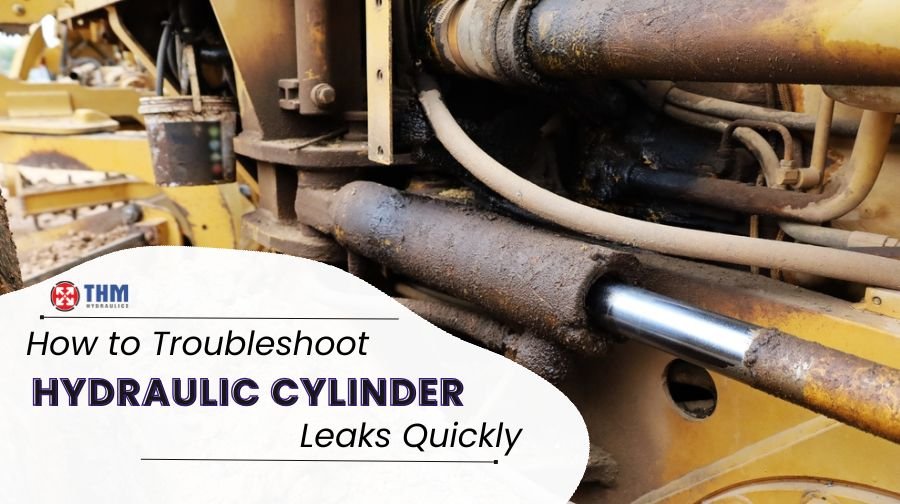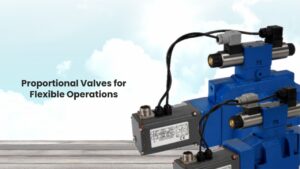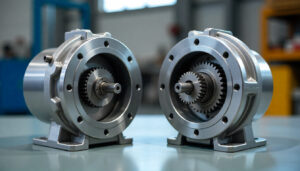Hydraulic cylinder plays a crucial role in the operation of industrial and construction machinery. Nevertheless, the most superior forms of hydraulic cylinders are subject to leakages as time goes by. Industrial hydraulic cylinders or a hydraulic cylinder used in construction equipment, early detection and repair of leaks will keep you out of the downtime and out of expensive damage.
Understanding the Hydraulic Cylinder Working Principle
In order to diagnose leaks appropriately, it is important to know the hydraulic cylinder working principle. A hydraulic cylinder is used to translate fluid power into linear mechanical energy. As pressurized hydraulic fluid is introduced to one side of the piston chamber, the piston rod is forced in or out, depending on the design.
Two are the primary types:
- Single acting cylinders: The pressure is applied in one direction only; the return is normally by spring or gravity.
- Double acting cylinders: The pressure is applied in both directions, and they are used when more control and force are required.
The knowledge of single acting vs double acting cylinder set ups can be used to isolate the possible leak problems according to their operation.
Common Signs of a Hydraulic Cylinder Leak
The following are the signs of leakage to look out before proceeding to troubleshooting:
- Ponding of oil around the bottom of the cylinder
- Lack of smooth or steady movement of equipment
- Low system pressure
- Strange sound when cylinder is working
- Oil dripping in the rod or gland region
Important Parts of Hydraulic Cylinder to Check
Being aware of the parts of the hydraulic cylinder will assist you to find and fix leaks. Important elements to consider are:
- Rod seal: Leak point most often seen
- Piston seal: may lead to internal leakage
- Wiper seal: It prevents rod contamination by external substances
- Cylinder barrel: Can crack or wear out
- Rod and rod eye: Examine to see whether scratched, bent or scored
The Step by Step Guide on How to Troubleshoot Hydraulic Cylinder Leaks
- Safety First
- Before inspection:
- Shut down the system
- Blow off the hydraulic system
- Wear protective clothing
- Clean Cylinder
Clean off any oil, dirt or debris with a lint free cloth and degreaser. This facilitates the identification of leaks in progress.
- Visual Inspection
- Check all mounting points, connections and seals:
- Search the rod area for oil residue
- Inspect the rod to see whether there are nicks or scratches on it
- Inspect seal housing and ports
- Inspect Rod Damage
- A curved or scored rod can rupture seals in short order causing leaks. In case of damage of the rod:
- Re machine it or replace it
- Make sure that the rods are aligned with the load
- Test Pressure
Performance under load can be monitored using a pressure gauge. The loss of pressure may be a sign of an internal leakage at the piston seal.
- Seal Replacement
- In case of worn or damaged seals:
- Take the cylinder apart
- Installation of replacement kits approved by the manufacturer on faulty seals
- Reconnect and leak check once more
How to Repair a Hydraulic Cylinder Leak
- Disassembly- Use the right tools to avoid damaging the cylinder parts.
- Replacement of Seals-It is necessary to replace all the seals when one of them fails.
- Wear Bands Evaluation- Worn bands may cause misalignment thus causing leakage.
- Testing of Internal Surfaces-In case of scoring, the cylinder barrel ought to be honed.
- Reassembly and Bleeding- The cylinder must be filled back up and the air taken out of the system.
In case of industrial cylinders, it is wise to contact an experienced technician or ship the cylinder to an authorized repair shop.
Tips for Preventing Future Leaks
- Routine Inspection- Minor concerns are identified early to avoid their growth.
- Quality Seals- Use OEM approved seals everywhere.
- Contamination Protection- Wiper seals and dust boots offer protection to outside agents.
- Prevention of Overloads- Prevent side-loading, and alignment.
- Check Hydraulic Fluid- Dirty or old fluid will wear the seals out.
Conclusion – Keep Your Hydraulic Systems Running Smoothly
Leaks of hydraulic cylinders do not always show that a full replacement of the cylinder is required. Thorough knowledge of the hydraulic cylinder operation, the knowledge of the most common failure modes, and a well disciplined regimen of routine inspection allow early detection and correction of faults. Be it in construction machinery or in large industrial facilities, this preventative approach, along with effective repair philosophy is a must to effective operation.
THM Huade focuses on fault detection at an early stage and the use of high quality components to reduce the downtime and increase the reliability of equipment. Leak repairs at the initial stages can avoid a further problem and increase the lifetime of the system. Also, the distinction between single acting and double acting cylinders allows maintenance staff to better fulfill their duties and, therefore, raises the overall performance.
FAQs
Q: 1 What causes hydraulic cylinders to leak?
Leaks are in most cases caused by worn or damaged seals, contaminated hydraulic fluid or physical damage to the rod or barrel.
Q: 2 Can I repair a leaking hydraulic cylinder myself?
Sure, as long as you possess the required tools and a good idea of how to repair a hydraulic cylinder; it is possible to replace the seals and other parts of the hydraulic cylinder that are worn out. But in case of complicated industrial hydraulic cylinders, it is advisable to seek professional help.
Q: 3 What is the difference between single acting vs double acting cylinder?
A single acting cylinder exerts force in one direction whereas a double acting cylinder exerts force in both directions. The choice is based on the application in question.
Q: 4 How to check if a hydraulic cylinder is leaking?
Check the obvious oil on the rod, seals or fittings, and check power loss or wild cylinder action.
Q: 5 Why is my hydraulic cylinder leaking?
Worn seals, damaged rods or contaminated fluid that causes faster degradation of the seals often cause leaks.



